THYMOQUINONE
Synonym(s):2-Isopropyl-5-methyl-1,4-benzoquinone
- CAS NO.:490-91-5
- Empirical Formula: C10H12O2
- Molecular Weight: 164.2
- MDL number: MFCD00001602
- EINECS: 207-721-1
- SAFETY DATA SHEET (SDS)
- Update Date: 2024-12-18 14:07:02
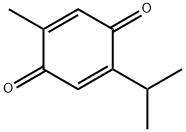
What is THYMOQUINONE?
Description
Thymoquinone is an allergen In different cedar species.
Chemical properties
orange to brown crystals
The Uses of THYMOQUINONE
Thymoquinone is a phytochemical compound found in the plant Nigella sativa. Thymoquinone has antioxidant effects and has been shown to protect against heart, liver and kidney damage in animal studies, as well as having possible anti-cancer effects. Thymoquinone also has analgesic and anticonvulsant effects in animal models. Thymoquinone is an angiogenesis inhibitor.
The Uses of THYMOQUINONE
Thymoquinone is a phytochemical compound found in the plant Nigella sativa. Thymoquinone has antioxidant effects and has been shown to protect against heart, liver and kidney damage in animal studies, as well as having possible anti-cancer effects. Thymoquinone also has analgesic and anticonvulsant effects in animal models. Thymoquinone is an angiogenesis inhibitor. An IRAK1 inhibitor with in vivo and in vitro anti-inflammatory activities. Dyes and metabolites.
What are the applications of Application
Thymoquinone is a phytochemical that inhibitis tumor angiogenesis
Definition
ChEBI: Thymoquinone is a member of the class of 1,4-benzoquinones that is 1,4-bezoquinone in which the hydrogens at positions 2 and 5 are replaced by methyl and isopropyl groups, respectively. It is a natural compound isolated from Nigella sativa which has demonstrated promising chemotherapeutic activity. It has a role as an anti-inflammatory agent, an antioxidant, an adjuvant, an antineoplastic agent, a cardioprotective agent, an antidepressant and a plant metabolite.
Contact allergens
Thymoquinone is an allergen in different cedar species, Cupressaceae family, such as incense cedar (Calocedrus decurrens Florin) used for pencils, chests or toys, and western cedar (Thuja plicata Donn.) as used for hard real- izations such as construction or boats.
Anticancer Research
The black cumin (Nigella sativa) that has a long history of medicinal use contains aphytochemical called thymoquinone (2-methyl-5-isopropyl-1,4-benzoquinone)(Padhye et al. 2008; Khan et al. 2011). In the regions of Southeastern Asia, Africa,Arab and the Mediterranean, the black cumin seeds have a notable history in traditionalmedicine practices. In ancient Egypt, Greece and Turkey, black cumin seedswere often used to treat many diseases and ailments (Padhye et al. 2008; Salih et al.2009; Khan et al. 2011; Ahmad et al. 2013). The Nigella sativa plant seeds and oilare used for medicinal purposes, and they are known for their hepatoprotective,renal-protective, antimicrobial, antidiabetic, anticancer, antihypertensive, analgesic,anti-inflammatory, immunomodulatory, spasmolytic, gastro-protective, bronchodilativeand antioxidant activities (Salih et al. 2009; Khan et al. 2011; Ahmad et al.2013). Recently, Barkat et al. (2017) reported that administration of thymoquinoneto MDA-MB-231 acts on cell cycle and inhibits progression from G1 to S phase bytargeting the cell cycle-related proteins such as cyclin D1, cyclin E and p27. It alsoexhibits histone deacetylase (HDAC) inhibitory effects, targets p21 and Maspin andinduces pro-apoptotic gene, Bax, and downregulates anti-apoptotic gene Bcl-2(Barkat et al. 2017).
Thymoquinone is the primary bioactive constituent of seed oil of Nigella sativa. It is a chemopreventiveagent and suppresses the proliferation of breast, colorectal, leukemia, osteosarcoma,ovarian, and pancreatic cancer cells. It suppresses TNF-inducedactivationof NF-κB in a time- and dose-dependent manner and the subsequent inhibition ofIκBα kinase activation, IκBα degradation, phosphorylation, p65 nuclear translocation,and phosphorylation. It specifically suppresses the nuclear p65 and recombinantp65 direct binding to DNA. It also downregulates the expression ofNF-κB-regulated antiapoptotic (survivin, IAP1, Bcl-xL, XIAP IAP2, Bcl-2), proliferative(cyclin D1, c-myc, and COX-2), and angiogenic (VEGF and MMP-9) geneproducts. It suppresses the activation of ERK and AKT pathways and blocks in vitroand in vivo angiogenesis (Aggarwal et al. 2008).
Anticancer Research
Thymoquinone acts on cell cycleand inhibits progression from G1 toS phase by targeting the cellcycle-related proteins such as cyclinD1, cyclin E and p27.It also exhibits histone deacetylase(HDAC) inhibitory effects andtargets p21 and Maspin.Induces pro-apoptotic gene, Bax,and downregulates anti-apoptoticgene Bcl-2
Barkat et al.(2017)
Properties of THYMOQUINONE
| Melting point: | 45-47 °C(lit.) |
| Boiling point: | 230-232 °C(lit.) |
| Density | 1.0326 (rough estimate) |
| refractive index | 1.5155 (estimate) |
| Flash point: | 219 °F |
| storage temp. | Sealed in dry,Room Temperature |
| solubility | Chloroform (Slightly, Heated), Ethanol (Slightly), Methanol (Slightly) |
| form | Solid |
| color | Light Orange to Dark Yellow |
| Stability: | Light Sensitive |
| CAS DataBase Reference | 490-91-5(CAS DataBase Reference) |
| EPA Substance Registry System | 2,5-Cyclohexadiene-1,4-dione, 2-methyl-5-(1-methylethyl)- (490-91-5) |
Safety information for THYMOQUINONE
| Signal word | Warning |
| Pictogram(s) |
 Exclamation Mark Irritant GHS07 |
| GHS Hazard Statements |
H302:Acute toxicity,oral H315:Skin corrosion/irritation H319:Serious eye damage/eye irritation H335:Specific target organ toxicity, single exposure;Respiratory tract irritation |
| Precautionary Statement Codes |
P261:Avoid breathing dust/fume/gas/mist/vapours/spray. P264:Wash hands thoroughly after handling. P264:Wash skin thouroughly after handling. P270:Do not eat, drink or smoke when using this product. P301+P312:IF SWALLOWED: call a POISON CENTER or doctor/physician IF you feel unwell. P302+P352:IF ON SKIN: wash with plenty of soap and water. P305+P351+P338:IF IN EYES: Rinse cautiously with water for several minutes. Remove contact lenses, if present and easy to do. Continuerinsing. |
Computed Descriptors for THYMOQUINONE
New Products
(S)-3-Aminobutanenitrile hydrochloride 4-Methylphenylacetic acid N-Boc-D-alaninol N-BOC-D/L-ALANINOL Tert-butyl bis(2-chloroethyl)carbamate 3-Morpholino-1-(4-nitrophenyl)-5,6-dihydropyridin- 2(1H)-one Furan-2,5-Dicarboxylic Acid Tropic acid 1-Bromo-3,5-Di-Tert-Butylbenzene S-2-CHLORO PROPIONIC ACID ETHYL ISOCYANOACETATE 2-Bromo-1,3-Bis(Dimethylamino)Trimethinium Hexafluorophosphate 4-IODO BENZOIC ACID 3-NITRO-2-METHYL ANILINE 1-(2,4-DICHLOROPHENYL) ETHANAMINE (2-Hydroxyphenyl)acetonitrile 4-Bromopyrazole 2-(Cyanocyclohexyl)acetic acid 4-methoxy-3,5-dinitropyridine 1-(4-(aminomethyl)benzyl)urea hydrochloride 2-aminopropyl benzoate hydrochloride diethyl 2-(2-((tertbutoxycarbonyl)amino) ethyl)malonate tert-butyl 4- (ureidomethyl)benzylcarbamate Ethyl-2-chloro((4-methoxyphenyl)hydrazono)acetateRelated products of tetrahydrofuran

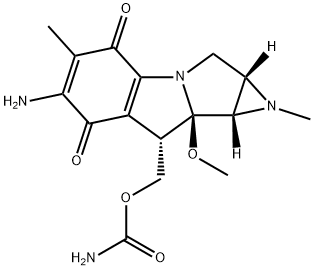
![PORFIROMYCIN, [METHYL-3H]-](https://img.chemicalbook.in/StructureFile/ChemBookStructure4/GIF/CB4298771.gif)
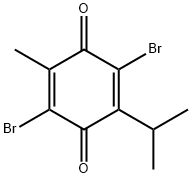
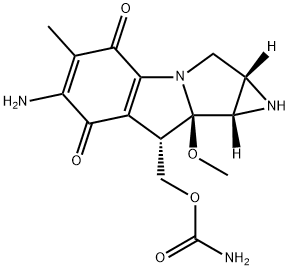
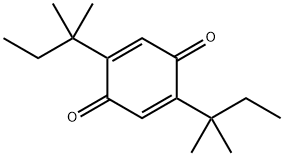
![3-HYDROXY-2-[(1R,6R)-3-METHYL-6-(1-METHYLETHENYL)-2-CYCLOHEXENE-1-YL]-5-PENTYL-2,5-CYCLOHEXADIENE-1,4-DIONE](https://img.chemicalbook.in/CAS/GIF/137252-25-6.gif)

You may like
-
 Thymoquinone, ≥98% CAS 490-91-5View Details
Thymoquinone, ≥98% CAS 490-91-5View Details
490-91-5 -
 Thymoquinone CAS 490-91-5View Details
Thymoquinone CAS 490-91-5View Details
490-91-5 -
 Thymoquinone CAS 490-91-5View Details
Thymoquinone CAS 490-91-5View Details
490-91-5 -
 Thymoquinon 98.00% CAS 490-91-5View Details
Thymoquinon 98.00% CAS 490-91-5View Details
490-91-5 -
 1975-50-4 98%View Details
1975-50-4 98%View Details
1975-50-4 -
 2-HYDROXY BENZYL ALCOHOL 98%View Details
2-HYDROXY BENZYL ALCOHOL 98%View Details
90-01-7 -
 14714-50-2 (2-Hydroxyphenyl)acetonitrile 98+View Details
14714-50-2 (2-Hydroxyphenyl)acetonitrile 98+View Details
14714-50-2 -
 118753-70-1 98+View Details
118753-70-1 98+View Details
118753-70-1